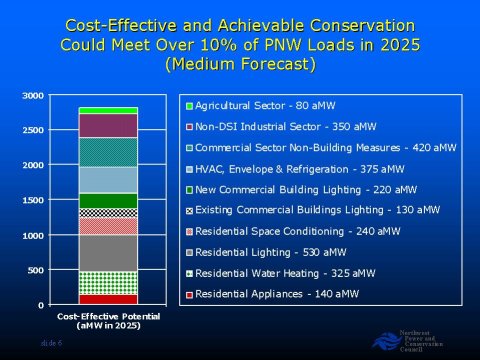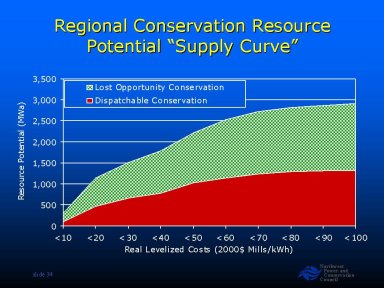forum
library
tutorial
contact

Council Identifies 2,800 aMW of Cost-Effective,
Achievable Regional Conservation through 2025
Mark Ohrenschall
Con.Web, May 28, 2004
|
the film forum library tutorial contact |

|
Council Identifies 2,800 aMW of Cost-Effective,
Mark Ohrenschall
|
Bright Future
Energy conservation has a promising regional future, brightened by technology advances and forecasted higher power prices, according to the Northwest Power and Conservation Council's latest assessment.
The Council's draft regional plan identifies 2,800 average megawatts of potential energy savings regionwide through 2025. Those would-be efficiencies are deemed both cost-effective--an average cost of 2.4 cents per kilowatt-hour--and achievable.
This aggregate conservation potential is similar to the region's historic energy-saving accomplishments.
It exceeds 10 percent of projected total regional loads in 2025, and half the prospective Northwest load increases over the next 20 years, under medium-growth scenarios, according to the Council. It's also nearly double the approximately 1,500 aMW of cost-effective regional energy savings outlined in the last regional plan, from 1998.
 Residential-sector potential heads the parade of possibilities, at 1,235 aMW, highlighted by 530 aMW of lighting. Commercial energy savings are estimated at 1,145 aMW, in building and non-building applications. Industrial efficiencies are projected at an admittedly uncertain 350 aMW, with irrigated agriculture at 80 aMW.
Residential-sector potential heads the parade of possibilities, at 1,235 aMW, highlighted by 530 aMW of lighting. Commercial energy savings are estimated at 1,145 aMW, in building and non-building applications. Industrial efficiencies are projected at an admittedly uncertain 350 aMW, with irrigated agriculture at 80 aMW.
If the region steadily acquires this conservation, power system costs would shrink $500 million (net present value). The risk reduction value is an estimated $1.5 billion, according to the Council.
However, the Council estimates an annual total resource cost of $380 million for this level of conservation. That's nearly triple the average annual regional conservation spending from 1997 through 2002, and exceeded in recent history only in the boom years of 1993 and 1994.
Realizing this abundant potential would require substantially more spending or more efficient approaches, the Council believes.
Translating the Council's voluntary goals into tangible results is another matter altogether. Asked later about prospects for regional attainment of the Council's energy-saving targets, power division director Dick Watson acknowledged difficulties, especially with conservation's rate impacts on utilities and Bonneville Power Administration. "It's always been a tugging and a hauling to get it done," he said. "I'm sure it'll be that way again. I also think the benefits justify it."
Historical Record: Almost 3,000 aMW
Nearly 3,000 aMW of savings have accrued from 1980 through 2002 in rhe Northwest, from utility/Bonneville Power Administration programs, energy codes and federal efficiency standards, according to Council figures.
A comparable amount can be had over the next 20 years, outlined Council conservation resources manager Tom Eckman in a May 19 presentation to the National Association of Energy Service Companies' midyear conference in Seattle.
Eckman summarized this affordable and doable energy-saving resource as large and inexpensive, consisting of "new stuff" and "improved old stuff," but also capital-intensive and rate-affecting for utilities.
"It requires more money or more efficient ways to deliver" than in the past, he told NAESCO conference attendees. However, he concluded, "It will cost the region a lot more money if we fail."
Technology Advances, Higher Power Prices
Two major factors have boosted the region's conservation potential, compared to the last Council plan.
One is improved technology. High-performance T-8 fluorescent lighting, compact fluorescent lamps and optimized controls are three examples cited by Eckman. Altogether, advances in energy-saving gadgetry have increased regional conservation potential by 1,240 aMW, the Council reports.
 Another significant bump comes from Council projections for higher power market prices. The Council's last plan forecast market prices through 2015 in a tight band between 2 cents/KWh and 4 cents/KWh. In this draft plan, the low-end forecast covers a similar range, but summertime price spikes are envisioned to 10 cents/KWh and slightly beyond in the coming decade--fueled by California and desert Southwest loads, Eckman said. "The West Coast markets generate a different value in what we want to search for and do" in Northwest conservation.
Another significant bump comes from Council projections for higher power market prices. The Council's last plan forecast market prices through 2015 in a tight band between 2 cents/KWh and 4 cents/KWh. In this draft plan, the low-end forecast covers a similar range, but summertime price spikes are envisioned to 10 cents/KWh and slightly beyond in the coming decade--fueled by California and desert Southwest loads, Eckman said. "The West Coast markets generate a different value in what we want to search for and do" in Northwest conservation.
These higher avoided costs add 767 aMW to regional energy-saving prospects.
At the same time, the Council draft subtracts energy-saving possibilities because of new and revised federal efficiency standards (730 aMW), utility program acquisitions (600 aMW) and regional market-transforming actions (170 aMW).
The net gain in regional energy-saving potential is about 500 aMW.
New data--such as the Assessment of the Commercial Building Stock in the Pacific Northwest and other sources--also figures into this assessment.
Residential, Commercial, Industrial, Agricultural
The biggest regional conservation bonanza over the next two decades is right at home.
Residential-sector savings through 2025 are listed at 1,235 aMW. Lighting tops cost-effective and achievable household measures, at 530 aMW, with an average cost of 1.7 cents/KWh. "CFLs now cost under $3," Eckman said. "Last time we looked they cost $12, just five years ago."
Residential water-heating measures, such as heat pump water-heaters, could contribute 325 aMW. Space conditioning measures (notably including heat pump conversions and upgrades, and duct sealing) come in at 240 aMW, followed by appliances--almost entirely clothes washers--at 140 aMW.
In the commercial sector, building efficiencies could reap 725 aMW, in the categories of HVAC, envelope and refrigeration (375 aMW), new commercial building lighting (220 aMW) and existing commercial building lighting (130 aMW).
Efficient power supplies, municipal water and sewage treatment facilities, personal computer networks, light-emitting diode exit signs and traffic lights, and other non-building applications total 420 aMW.
The industrial sector (excluding aluminum smelters) could be the source of 350 aMW over 20 years, at 1.7 cents per KWh, through improvements in such features as process controls, drive systems, lighting and refrigeration. However, Eckman acknowledged much uncertainty over future industrial loads in the region and, accordingly, in the efficiency potential.
Irrigated agriculture, meanwhile, could generate 80 aMW of savings, through lower pressures on center-pivot watering systems and replacement of pumps, nozzles and gaskets.
Altogther, the potential energy savings are divided almost equally between lost opportunity and "dispatchable." That distinguishes between conservation measures done or else unavailable for a long time (as in new construction) and energy savings more frequently accessible.
Lost opportunity savings are cumulatively more expensive, representing about $225 million of the $380 million total annual resource cost for 150 aMW of savings.
"Because we're so good at improving codes and standards in this region, and nationally with respect to appliances, you're reaching into the law of diminishing returns in new construction," said Eckman.
But, he said, "We're not going to get the product mix ... if we focus only on what it costs out of the gate. If you only invest in short-lifetime measures, or things that are just cheap up-front, that's not going to get us where we need to go."
Related Pages:
NPCC Analyses Look at NW Power Supply Columbia Basin Bulletin,3/5/4
Bullish on Conservation by Mark Ohrenschall , Con.Web 5/28/4
learn more on topics covered in the film
see the video
read the script
learn the songs
discussion forum
